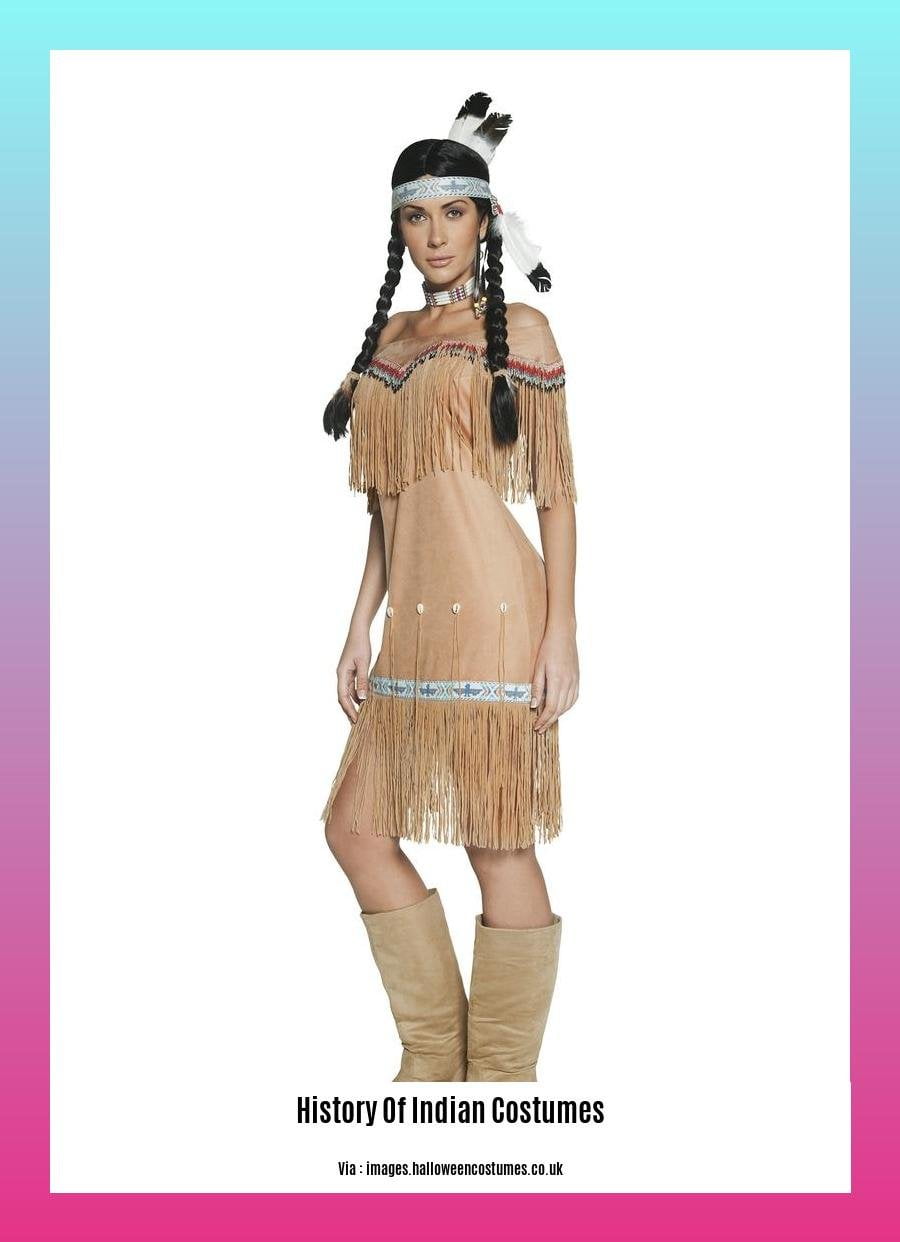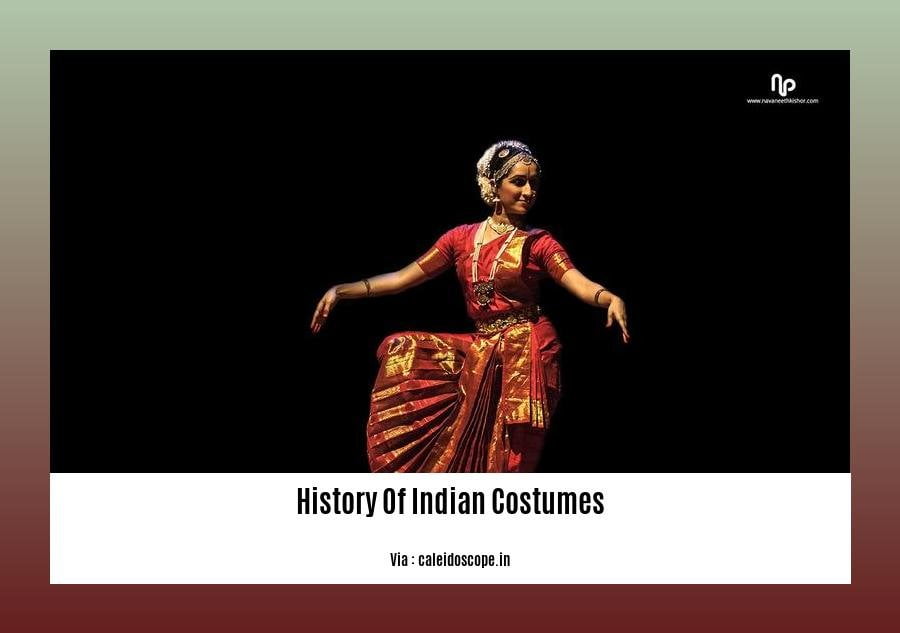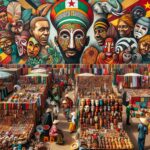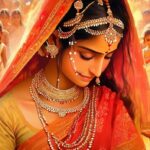Embark on a mesmerizing journey as we explore the fascinating history of Indian costumes in our article, “Stepping Through Time: Unraveling the History of Indian Costumes.” With its vibrant hues, intricate embroideries, and rich symbolism, Indian attire stands as a testament to the country’s diverse cultural heritage. Join us as we unravel the stories woven into these garments, tracing their evolution across dynasties, deciphering their hidden meanings, and celebrating their enduring influence on the global fashion landscape.
Key Takeaways:
- Indian clothing is diverse due to ethnicity, geography, climate, and cultural traditions.
- Traditional attire for women includes saris, lehengas, and ghagra cholis.
- Western clothing is common in urban areas.
- India has a rich variety of weaves, fibers, colors, and materials in its clothing.
- Color codes are sometimes followed based on religion and rituals.
- Indian clothing features a variety of embroidery, prints, handwork, embellishments, and styles.
- A blend of traditional and Western styles is seen in Indian clothing.
- Climate, culture, religion, and Western influences have shaped Indian clothing’s evolution.
- India’s long history and diverse cultural heritage are reflected in its clothing traditions.
History of Indian Costumes

Have you ever wondered how the vibrant and diverse costumes of India came to be? From the elegant saris to the regal lehengas, each garment holds a unique story, deeply intertwined with the country’s rich cultural heritage. Let’s embark on a journey through the history of Indian costumes, exploring the influences, symbolism, and evolution of these captivating sartorial creations.
The Roots of Indian Attire
The history of Indian costumes can be traced back to the ancient Indus Valley Civilization, where cotton was cultivated and woven into garments. These early textiles were adorned with intricate designs and vibrant colors, reflecting the region’s rich artistic traditions. As trade flourished, Indian fabrics and clothing styles began to influence cultures across the globe.
Draped in Elegance: The Sari
The sari, an iconic symbol of Indian womanhood, has its origins in the ancient draped garments worn by women in the Indus Valley Civilization. Over the centuries, the sari evolved into a versatile and graceful ensemble, consisting of a long piece of fabric draped around the body and paired with a blouse and petticoat. The sari’s versatility lies in its ability to adapt to regional variations, resulting in a dazzling array of styles, fabrics, and embellishments.
Regal Splendor: The Lehenga
The lehenga, a majestic skirt paired with a choli (blouse) and dupatta (scarf), originated in the royal courts of Rajasthan and Gujarat. This ensemble exudes an aura of opulence and grandeur, with its vibrant colors, intricate embroidery, and rich fabrics. Lehengas are often worn for special occasions such as weddings and festivals, where they showcase the wearer’s cultural pride and heritage.
Symbolism and Cultural Significance
Indian costumes are not merely garments; they are imbued with deep cultural significance and symbolism. Colors, fabrics, and motifs are carefully chosen to convey messages, evoke emotions, and reflect the wearer’s identity. For instance, red is often associated with auspicious occasions, while white is reserved for mourning. Embroidery and embellishments carry symbolic meanings, such as peacocks representing royalty and elephants symbolizing strength.
Evolution and Modern Adaptations
The history of Indian costumes is a dynamic one, marked by continuous evolution and adaptation to changing times. The influence of globalization and Western fashion trends has led to the emergence of fusion styles that blend traditional Indian elements with contemporary silhouettes. Designers are experimenting with innovative fabrics, cuts, and embellishments, creating a new generation of Indian costumes that are both rooted in tradition and forward-looking.
Celebrating India’s Textile Heritage
India’s textile industry has a long and illustrious history, with each region boasting its unique weaving, printing, and embroidery techniques. From the intricate brocades of Varanasi to the vibrant bandhani of Rajasthan, Indian textiles showcase the country’s diverse craftsmanship and artistry.
Indian costumes serve as a testament to the country’s rich cultural heritage, reflecting its diverse traditions, beliefs, and artistic expressions. They are not just garments but powerful symbols of identity, embodying the spirit of a nation that is proud of its past and embraces its future.
- Do you want to know about the captivating history of Ibadan? Find out here.
- Get ready to uncover all the fascinating chronicles about Indian clothing, just click to explore!
- Are you a fan of motorcycles? If so, you won’t want to miss out on the enthralling history of the Indian Motorcycle Company. You can find out more about its heritage online.
- Discover the intriguing history of the Indian Orthodox Church, by clicking here for more information.
Symbolism and motifs: Deciphering the hidden meanings and symbolism embedded in traditional Indian garments, shedding light on their cultural significance.

Underneath the vibrant hues and intricate embellishments of traditional Indian attire lies a hidden language of symbolism and motifs, a secret code that speaks to the wearer’s identity, status, and beliefs. Each garment tells a story, encoded in the patterns, colors, and fabrics that adorn it.
Motif Mania: A Visual Vocabulary
Indian costumes are a canvas for a myriad of motifs, each carrying its own unique meaning. From the paisley, symbolizing fertility and prosperity, to the lotus, representing purity and enlightenment, these motifs are visual cues that communicate messages beyond the realm of words.
Color Commentary: A Palette of Symbolism
Colors in Indian attire are not mere aesthetics; they are vibrant storytellers. Red, the color of passion and power, commands attention. Green, the hue of nature and new beginnings, brings a sense of tranquility. Blue, the color of the divine, evokes a sense of serenity.
Fabric Folklore: A Tapestry of Traditions
The choice of fabric in Indian costumes is not random. Silk, the fabric of royalty, exudes luxury and opulence. Cotton, the fabric of the masses, is comfortable and breathable, perfect for India’s tropical climate. Wool, the fabric of warmth, is a winter staple, keeping the wearer cozy in the colder months.
Now, let’s step into the world of symbolism and motifs in Indian costumes with a few captivating examples:
- The Marigold Motif: A symbol of auspiciousness and joy, often used in wedding attire.
- The Peacock Motif: A symbol of beauty, grace, and royalty, often found in Mughal-era costumes.
- The Elephant Motif: A symbol of strength, power, and wisdom, often found in temple art and traditional textiles.
- The Lotus Motif: A symbol of purity, enlightenment, and spiritual growth, often used in religious garments.
These are just a few examples of the rich tapestry of symbolism and motifs that adorn Indian costumes, each telling its own unique story.
Key Takeaways:
- Symbolism and motifs in Indian costumes are a visual language that communicates messages beyond words.
- Motifs, such as the paisley and lotus, carry specific meanings and convey cultural narratives.
- Colors in Indian attire are not just aesthetics but also symbolic, with each hue representing different emotions and ideas.
- The choice of fabric in Indian costumes is influenced by tradition, climate, and the wearer’s status.
- Symbolism and motifs in Indian costumes are a fascinating aspect of Indian culture, reflecting the country’s rich heritage and traditions.
Sources:
- Symbolism in Indian Culture and Its Significance
- Motifs in Indian Art and Culture
Regional diversity: Exploring the vibrant regional variations in Indian costumes, showcasing the distinct styles and traditions from different parts of the country.
Across India’s vibrant tapestry of cultures, the allure of regional diversity weaves its way into the very fabric of traditional costumes. From the delicate weaves of the Banarasi silk saree to the mirror-work magic of Rajasthan’s poshak, each region sings its own sartorial symphony.
North India: A Regal Symphony of Elegance
In the heart of the North, elegance takes center stage. The salwar kameez with its graceful churidars or the majestic sherwani radiate an aura of royalty. Pashmina shawls from Kashmir, intricately embroidered, lend an air of timeless sophistication.
East India: Where Silks Dance with Tradition
The East unfolds a world of shimmering silks and vibrant weaves. Bengal’s muslin weaves tales of ethereal lightness, while Assam’s mekhela chador stuns with its colorful motifs. Orissa’s ikat sarees, with their mesmerizing patterns, echo the rhythm of ancient traditions.
West India: A Kaleidoscope of Color and Craft
In the West, vibrant hues paint a picture of joy and celebration. Gujarati chaniya cholis, resplendent with mirror work and embroidery, mirror the region’s infectious energy. Maharashtra’s nauvari sarees, with their distinctive nine-yard drape, exude an air of elegance and grace.
South India: A Drape of Grace and Grandeur
The South unfurls a symphony of drapes, each a testament to time-honored craftsmanship. The iconic Kanjeevaram silk saree, with its rich zari work, speaks of opulence and grandeur. Kerala’s kasavu sarees, with their pristine white borders, embody the purity and simplicity of the region.
Key Takeaways:
Regional costumes in India mirror the diversity of the country’s cultures, traditions, and climates.
North India showcases regal elegance with garments like the salwar kameez and sherwani, complemented by exquisite pashmina shawls from Kashmir.
East India captivates with its shimmering silks, from Bengal’s ethereal muslin to Assam’s vibrant mekhela chador and Orissa’s mesmerizing ikat sarees.
West India bursts with color and craft, featuring Gujarati chaniya cholis adorned with mirror work and embroidery, and Maharashtra’s graceful nauvari sarees.
South India unveils a drape of grace and grandeur, with the opulent Kanjeevaram silk sarees and the pristine white kasavu sarees of Kerala.
Jerry Fashion Blog: Exploring the Regional Diversity of Indian Sarees
Wikipedia Article on Saree
Global impact: Examining the influence of Indian costumes on global fashion trends, highlighting their contribution to the international fashion scene.
Throughout history, Indian costumes have transcended geographical borders, leaving an enduring mark on the global fashion landscape. The vibrant hues, intricate embroideries, and flowing silhouettes have captivated designers and fashion enthusiasts worldwide, contributing to the rich tapestry of international fashion. Let’s delve into the fascinating journey of Indian costumes on the global stage.
Key Takeaways:
Timeless Elegance: The sari, an iconic Indian garment, has gained international recognition for its timeless elegance and versatility. Its ability to adapt to diverse cultures and styles has made it a favorite among fashionistas worldwide.
Cross-Cultural Influences: Indian textiles, adorned with intricate motifs and patterns, have significantly influenced various global fashion trends. From paisley prints to ikat weaving, these designs have found their way into international runways and everyday wardrobes.
Bollywood Effect: The rise of Bollywood films has played a pivotal role in popularizing Indian costumes on a global scale. The vibrant costumes, often adorned with rich embellishments and traditional motifs, have captured the attention of audiences worldwide, inspiring fashion trends and cultural appreciation.
Fusion Fashion: Contemporary fashion designers have embraced the fusion of Indian elements with modern silhouettes, creating unique and eye-catching designs. This blend of traditional and contemporary styles has resulted in a new wave of fashion that celebrates cultural diversity and individuality.
Global Recognition: The growing appreciation for Indian costumes has led to their inclusion in prestigious fashion events and exhibitions worldwide. Designers from India have showcased their creations on international platforms, gaining recognition and accolades for their artistry and craftsmanship.
Cultural Exchange: The exchange of ideas and influences between Indian and international fashion designers has fostered a dynamic environment where both parties learn from and inspire each other. This cross-pollination of creativity has resulted in innovative and groundbreaking designs that push the boundaries of fashion.
Conclusion:
Indian costumes have played a significant role in shaping the global fashion landscape, leaving an indelible mark on the world of style and design. Their unique aesthetics, cultural significance, and versatility have captivated fashion enthusiasts worldwide, inspiring trends, and fostering cultural exchange. As the world continues to embrace diversity and celebrate cultural heritage, Indian costumes will undoubtedly continue to be a source of inspiration and admiration, enriching the global fashion scene with their timeless beauty and captivating charm.
Sources:
- The Influence of Indian Fashion on the Global Fashion Industry
- Indian Fashion: A Global Phenomenon
FAQ
Q1: How did Indian costumes evolve over time?
A1: Indian costumes have evolved over time due to various factors such as climate, culture, religion, and Western influences. Different dynasties and rulers have also left their mark on Indian attire, contributing to its diverse and rich history.
Q2: What are some of the most iconic traditional Indian garments?
A2: Some of the most iconic traditional Indian garments include the sari, lehenga, ghagra choli, salwar kameez, and sherwani. Each of these garments holds cultural and historical significance and is worn for different occasions and regions in India.
Q3: How has Indian clothing been influenced by Western culture?
A3: Indian clothing has been influenced by Western culture through colonialism and globalization. The British rule in India led to the introduction of Western attire, which influenced the styles and silhouettes of Indian garments. Additionally, the rise of ready-to-wear clothing and the global fashion industry have further influenced Indian clothing trends.
Q4: What role does symbolism play in Indian costumes?
A4: Symbolism plays a significant role in Indian costumes. Various motifs, patterns, and colors carry deep meanings and often represent cultural beliefs, religious practices, or social status. For example, the paisley motif is often associated with fertility and prosperity, while the lotus flower symbolizes purity and enlightenment.
Q5: How has the Indian textile industry contributed to global fashion?
A5: India has a rich textile heritage, and its traditional textiles and crafts have made a significant contribution to global fashion. Indian textiles, such as silk, cotton, and wool, are renowned for their intricate designs, vibrant colors, and luxurious textures. Indian artisans and designers have also gained international recognition for their unique fusion of traditional and contemporary styles.















